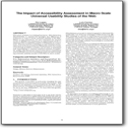论文成果 / Publications
2013
Hero: designing learning tools to increase parental involvement in elementary education in china
Abstract
In this paper, we present the design of Hero, a suite of learning tools that combine teacher-created extracurricular challenges with in-class motivational tools to help parents become more involved in their child's education, while also engaging students in their own learning. To inform the design, we conducted field studies and interviews involving 7 primary teachers and 15 different families. We analyzed Chinese parenting styles and problems related to parental involvement, and developed three major themes from the data. We then proposed three design goals and created a high-fidelity prototype after several iterations of user testing. A preliminary evaluation showed that teachers, parents, and students could all benefit from the design.
Exploring the effect of display size on pointing performance
Abstract
In this paper, we studied how display size affects human pointing performance given the same display field of view when using a mouse device. In total, four display sizes (10.6, 27, 46, 55 inches) and three display field of views (20, 34 and 45) were tested. Our findings show that given the same display field of view, mouse movement time significantly increases as display size increases; but there is no significant effect of display size on pointing accuracy. This research may contribute a new dimension to literature in describing human pointing performance on large displays.
软件学报|基于旋转模式的移动设备佩戴位置识别方法
Abstract
移动设备计算能力和传感能力的发展,使其可以为用户提供多种基于情境信息的服务,移动设备的佩戴位置作为一种重要的情境信息影响着其他用户活动的识别效果和移动应用的自适应功能分析得出当移动设备在不同身体部位佩戴时,旋转变化模式不同.提出了一种识别设备随身佩戴位置的方法该方法使用加速计与陀螺仪两种传感器进行数据融合,计算出旋转半径、角速度幅度和重力加速度并提取特征.在分类时,使用随机森林作为分类器,并与使用支持向量机的方案进行了对比,为了检验其效果.在包含3种佩戴位置和13种用户活动种类的公开数据集上进行了实验.实验结果显示,该方法能够达到平均95.39%的交叉验证准确率;同时表明,在满足旋转占主要成分和重力加速度方向稳定的前提下,使用旋转变化信息和集成分类器有助于提高分类效果.与之前的方法相比,该方法可以更准确地对佩戴位置进行区分,并对新用户与新活动类型情况下的位置识别具备更强的泛化能力.
2012
Clustering web pages to facilitate revisitation on mobile devices
Abstract
Due to small screens, inaccuracy of input and other limitations of mobile devices, revisitation of Web pages in mobile browsers takes more time than that in desktop browsers. In this paper, we propose a novel approach to facilitate revisitation. We designed AutoWeb, a system that clusters opened Web pages into different topics based on their contents. Users can quickly find a desired opened Web page by narrowing down the searching scope to a group of Web pages that share the same topic. Clustering accuracy is evaluated to be 92.4% and computing resource consumption was proved to be acceptable. A user study was conducted to explore user experience and how much AutoWeb facilitates revisitation. Results showed that AutoWeb could save up a significant time for revisitation and participants rated the system highly.
How much to share: A Repeated Game Model for Peer-to-Peer Streaming under Service Differentiation Incentive
Abstract
In this paper, we propose a service differentiation incentive for P2P streaming system, according to peers' instant contributions. Also, a repeated game model is designed to analyze how much the peers should contribute in each round under this incentive. Simulations show that satisfying streaming quality is achieved in the Nash Equilibrium state.
A Scalable Distributed Architecture for Intelligent Vision System
Abstract
The complexity of intelligent computer vision systems demands novel system architectures that are capable of integrating various computer vision algorithms into a working system with high scalability. The real-time applications of human-centered computing are based on multiple cameras in current systems, which require a transparent distributed architecture. This paper presents an application-oriented service share model for the generalization of vision processing. Based on the model, a vision system architecture is presented that can readily integrate computer vision processing and make application modules share services and exchange messages transparently. The architecture provides a standard interface for loading various modules and a mechanism for modules to acquire inputs and publish processing results that can be used as inputs by others. Using this architecture, a system can load specific applications without considering the common low-layer data processing. We have implemented a prototype vision system based on the proposed architecture. The latency performance and 3-D track function were tested with the prototype system. The architecture is scalable and open, so it will be useful for supporting the development of an intelligent vision system, as well as a distributed sensor system.
Inertial Body-worn Sensor Data Segmentation by Boosting Threshold-based Detectors
Abstract
Using inertial body-worn sensors, we propose a segmentation approach to detect when a user changes actions. We use Adaboost to combine three threshold-based detectors: force/gravity ratios, peaks of autocorrelation, and local minimums of velocity. Experimenting with the CMU Multi-Modal Activity Database, we find that the first two features are the most important, and our combination approach improves performance with an acceptable level of granularity.
Watching you moving the mouse, i know who you are
Abstract
Previous research on modeling human's pointing behavior focuses on user-independent variables such as target width and distance. In this work-in-progress, we investigate a set of user-dependent variables, which are drawn from cursor trajectory data and may represent an individual user's unique pattern when controlling mouse movement. Using these features, the 8 users in our experiment can be recognized at a promising accuracy as high as 87.5%.
UI Portals: Sharing Arbitrary Regions of User Interfaces on Traditional and Multi-user Interactive Devices
Abstract
This paper introduces UI Portals, a novel approach to help users share their off-the-shelf applications' user interfaces on traditional and multi-user interactive devices among various platforms. Users can choose an application window or select parts of the window to share. In addition to the traditional single-user mouse-and-keyboard interaction, we provide support for simultaneous interactions on large multi-user interactive surfaces, like tabletops and multi-touch vertical surfaces. We describe the concepts and implementation mechanisms of this approach. Furthermore, we implement UI Portals Toolsets (UIPT), a prototype that demonstrates sharing arbitrary regions of user interfaces among multiple platforms without any change to the application source code. In UIPT, we design a windowing tool dedicated to large multi-user interactive surfaces to fully leverage the benefit of simultaneous interaction. Two typical scenarios demonstrate the utility of UIPT and show how UIPT can help users work with their familiar software applications on different displays and platforms.
